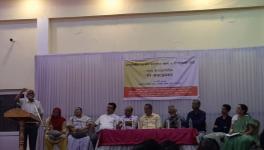Did Modi Govt Tweak Green Laws to Allow Oil and Gas Exploration in Assam’s Rainforests?

Image Courtesy: AFP
New Delhi: Even as large-scale displacement and environmental damage has been reported from the Baghjan oil well fire, the central government’s green nod to another Oil India Limited (OIL) project for exploring hydrocarbons underneath Assam’s rainforests has been challenged for having been granted without public hearings and after tweaking certain laws.
The Union Ministry of Environment, Forests & Climate Change (MoEF&CC) granted an environmental clearance to OIL on May 11, 2020 to drill wells for exploring hydrocarbons at seven locations under Assam’s ecologically fragile Dibru-Saikhowa National Park in Tinsukia district.
Through a Public Interest Litigation (PIL) filed in the Gauhati High Court, it has been demanded that environmental clearance for the project, which was granted without conducting any public hearing or environment impact assessment, be scrapped in the light of the disaster that has resulted from the Baghjan oil-well fire. It has been alleged in the PIL that OIL was exempted from the mandatory environmental impact assessment study with ‘retrospective effect’ after the central government amended a key environmental statute in January 2020.
“In January 2020, the Union environment ministry amended a central law as per which an environment impact assessment study was mandatory for any kind of exploration activity for hydrocarbons. This study was necessary for the project proponent to procure an environmental clearance. Now, as per the amended laws, all onshore and offshore oil and gas exploration projects are exempt from conducting this study. The exemption was extended to OIL on a retrospective basis because this particular project has been in the pipeline since 2015-16,” said Gauhati-based environmental lawyer Debajit Kumar Das.
On January 16, 2020, the MoEF&CC issued an amendment to the Environment Impact Assessment (EIA) Notification, 2006, a statute enacted by the then Congress-led United Progressive Alliance government for environmental protection, by issuing an extraordinary Gazette notification.
Through the amendment “all projects in respect of off-shore and onshore oil and gas exploration” were “categorized as ‘B2’ projects” as against their earlier classification as ‘Category A’ projects.
Industrial activities, like drilling to explore gas or oil, were earlier classified as ‘Category A projects’ for which an environment impact assessment study was mandatory as compared to ‘Category B2 projects’ which do not require any such assessment.
However, the process to grant environmental clearance for the project had been kicked off much before this statute was amended in January this year by the Bharatiya Janata Party-led National Democratic Alliance (NDA) government.
On August 3, 2016, the Expert Appraisal Committee (EAC) of the MoEF&CC had granted the Terms of Reference to OIL for this particular hydrocarbon exploration project, which also included holding of public consultations, before it was granted an environmental clearance.
However, public hearings for the project were ruled out in February 2017 by the NDA government using powers granted to it under the same EIA Notification, 2006. The OIL was granted exemption for the seven exploratory wells on the basis of public hearings that had been conducted in Tinsukia district six years ago and that too for a different project altogether. These hearings had been conducted in the year 2011 for a set of 26 development and 15 exploratory wells for another project of the OIL.
As per the minutes of the Union environment ministry’s Expert Appraisal Committee meeting on February 2017, wherein the project for seven exploratory wells under the national park was discussed:
“The PP [project proponent] requested that they may be allowed to use the earlier public hearing details conducted on 08. 07. 2011 and 26. 08. 2011 for Tinsukia district, in which the instant proposal falls.
The EAC [Expert Appraisal Committee] after detailed deliberations accepted the request made by the PP and recommended for exemption from public hearing under Para 7 (ii) of the EIA Notification, 2006”.
As per reports, on August 17, the Gauhati High Court issued notices upon the central government, the Union environment ministry and Oil India Limited to respond to the issues raised in the PIL. A copy of this order was, however, not yet uploaded on the website of the high court at the time that this report was being compiled.]
An email sent on behalf of NewsClick to the concerned officials of MoEF&CC, including its Secretary, to respond to the issues raised through the PIL is yet to elicit any reply too.
Also read: ‘Scandalising’ the Courts
The OIL has proposed in its project report that hydrocarbons will be extracted by drilling seven wells beneath the Dibru-Saikhowa National Park using the modern state-of-the-art technology called ‘Extended Reach Drilling’. Through this technology, drill pads will be placed at a distance of more than a kilometre from the forest boundary.
When contacted, the OIL informed that no physical activity whatsoever has begun on drilling the seven exploratory wells.
“Since this is a project that involves the usage of high-end technology, we will be selecting a technology partner for the work. Not even survey of land for the project has begun though there is a tentative idea about where the wells will be located. As a public sector unit, we are committed to whatever permission, mechanism or action is needed for drilling activities. We have been operating in the area for over 60 years and yet we have never displeased any local villager during drilling operations. None of the wells will be located in the midst of human settlements. We generally acquire barren land, farm land, crop land or tea gardens for drilling wells,” OIL spokesperson Tridiv Hazarika told the NewsClick.
However, local activists are far from convinced about the assurances of the public sector corporation in the backdrop of the Baghjan oil-well fire incident. The preliminary findings of a survey conducted in Baghjan by the Wildlife Institute of India to assess the impact of the blowout on flora and fauna of the area vindicate the fears of locals.
“The spill has resulted in mass mortality and severely impacting the environmental condition resulting in debilitating conditions for species to survive. The toxins released are known to have long-term persistence in soils and sediments, which will not only affect current life conditions, but due to sustained release over a long period, pose a serious health risk for the longer term. The current observations and communications with locals lead us to believe that there is no mitigation plan in place, let alone a comprehensive one,” states the report.
The institute has recommended for a comprehensive impact assessment of the current accident and, more importantly, observed that “it would be not only prudent but also essential for the well being of all life forms” that the approved new wells and explorations in this area should be initiated only after a thorough investigation of potential impact, as well as evaluating disaster handling capabilities in place, with appropriate technology and trained manpower. No such investigation was reportedly conducted before awarding the environment clearance to OIL for drilling seven new exploratory wells in Tinsukia.
“From the outset, it appears that OIL and the Union environment ministry have been hand-in-gloves with each other in the manner in which clearance has been granted for the project. Legally and technically, the agencies might be correct. But how can environment clearance be granted for seven exploratory wells in an ecologically fragile area without conducting any public hearings? It appears that nothing has been learnt from the Baghjan disaster,” said Trinayan Gogoi of a Dibrugarh-based NGO Green Buds Society.
On Monday, OIL claimed to have successfully capped well number 5 in Baghjan, which had caught fire, more than 80 days after the blowout. Locals allege that residents of about a dozen villages have been affected by the Baghjan disaster. Though the OIL has taken certain mitigative measures including setting up of relief camps for the displaced population, locals say that no compensation will ever be enough to match the impact that the accident has had on their lives and livelihoods.
“The numbers of displaced people are much more than the official figures because not each affected family has preferred to move to a relief camp. People have stayed back in villages with whatever they have been able to muster. A red zone has been declared wherein all farming and fishing activities are prohibited due to safety reasons. There is loss of livelihood. No one talks about the seismic tremors from the blowout that has resulted in cracks in most buildings in the area. And who will take stock of the deafening noise pollution in which villagers have been forced to live owing to the blowout?” Niranta Gohain, a resident of Natungaon in Tinsukia told NewsClick.
Also read: How JSW is Managing Bhushan Power Through Former Employees
The writer is an independent journalist.
Get the latest reports & analysis with people's perspective on Protests, movements & deep analytical videos, discussions of the current affairs in your Telegram app. Subscribe to NewsClick's Telegram channel & get Real-Time updates on stories, as they get published on our website.
























